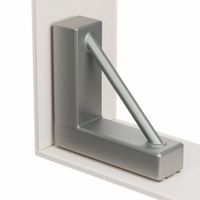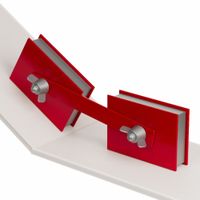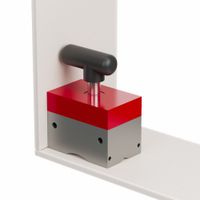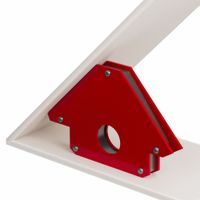Call +(254) 703 030 000 / 751 483 999 / 721 704 777
- Home
- Welding
- Weld Fixturing Marking Preparation
- Welding Magnets
.....Read More
Frequently Asked Questions
What are welding magnets used for?
Welding magnets are essential tools in the welding industry, used primarily to hold metal pieces in place during the welding process. They provide a stable and secure grip, allowing welders to work with precision and efficiency. These magnets are particularly useful for holding metal at specific angles, such as 45, 90, or 135 degrees, which are common in welding tasks. This capability is crucial for creating accurate joints and ensuring the structural integrity of the welded pieces.
The use of welding magnets eliminates the need for additional clamps or fixtures, simplifying the setup process and reducing the time required to prepare for welding. They are especially beneficial when working with ferrous metals, as their magnetic properties allow for a strong and reliable hold. This is particularly advantageous in situations where traditional clamps might not fit or when working in tight or awkward spaces.
Welding magnets come in various shapes and sizes, including arrow, square, and adjustable types, each designed to accommodate different welding needs and applications. Some advanced models feature on/off switches, allowing welders to easily position and release the magnet without disturbing the setup.
In addition to holding metal pieces, welding magnets can also be used for aligning and positioning metal sheets, pipes, and other components, ensuring that they are correctly aligned before welding. This helps in achieving cleaner welds and reducing the likelihood of errors or misalignments.
Overall, welding magnets are invaluable tools that enhance the efficiency, accuracy, and safety of welding operations, making them a staple in both professional and hobbyist welding environments.
How do welding magnets work?
Welding magnets are tools used to hold metal pieces in place during welding, ensuring precision and stability. They work based on the principles of magnetism, which involves the attraction of ferromagnetic materials like iron, steel, and certain alloys.
The core component of a welding magnet is a strong magnet, often made from materials like neodymium or ferrite, which generates a magnetic field. This field exerts a force on ferromagnetic materials, pulling them towards the magnet and holding them securely. The strength of the magnet determines the weight and size of the metal pieces it can hold.
Welding magnets are typically designed in specific shapes, such as arrows or triangles, to accommodate different angles and positions. This design allows them to hold metal pieces at common angles like 45, 90, and 135 degrees, facilitating various welding tasks. The shape and size of the magnet ensure that it can fit into tight spaces and hold pieces at precise angles, which is crucial for achieving accurate welds.
The magnets are often encased in a durable housing to protect them from heat and physical damage during welding. Some welding magnets also feature on/off switches, allowing the user to easily engage or disengage the magnetic field, making it easier to position and remove the magnet without disturbing the setup.
In summary, welding magnets utilize the attractive force of magnetism to hold metal pieces in place, providing stability and precision during welding operations. Their design and strength make them versatile tools for various welding applications, ensuring that metal pieces are aligned correctly for high-quality welds.
What are the different types of welding magnets?
Welding magnets come in various types, each designed to assist in holding metal pieces at specific angles during welding. The main types include:
1. **Arrow Welding Magnets**: These are the most common type, shaped like an arrowhead, allowing for holding workpieces at 45, 90, and 135-degree angles. They are versatile and used for a variety of welding tasks.
2. **Adjustable Welding Magnets**: These magnets have adjustable arms or joints, enabling them to hold metal pieces at custom angles. They are ideal for complex welding projects requiring non-standard angles.
3. **On/Off Switchable Magnets**: These magnets feature a switch to turn the magnetic force on or off, providing easy positioning and removal. They are useful for quick setups and adjustments.
4. **Magnetic Clamps**: These are designed to hold metal pieces together with a strong magnetic force, often used in place of traditional clamps. They come in various shapes and sizes for different applications.
5. **Pipe Magnets**: Specifically designed for holding round or cylindrical objects, these magnets are used in pipe welding to maintain alignment and position.
6. **Multi-Angle Magnets**: These magnets can hold workpieces at multiple angles, such as 30, 45, 60, 75, 90, and 135 degrees, offering flexibility for various welding tasks.
7. **Ground Clamps**: These magnets serve as a grounding point for welding, ensuring a stable electrical connection. They are essential for safety and efficiency in welding operations.
8. **Magnetic Squares**: These are used to hold metal pieces at precise right angles, ensuring accurate alignment and stability during welding.
Each type of welding magnet serves a specific purpose, enhancing precision, efficiency, and safety in welding operations.
How do you choose the right welding magnet for a project?
To choose the right welding magnet for a project, consider the following factors:
1. **Type of Welding Magnet**: Determine the type of magnet needed based on the project requirements. Options include arrow magnets for 45, 90, and 135-degree angles, adjustable magnets for custom angles, and on/off switchable magnets for easy repositioning.
2. **Holding Capacity**: Assess the weight and size of the materials to be welded. Choose a magnet with a holding capacity that exceeds the weight of the materials to ensure stability and safety.
3. **Material Compatibility**: Ensure the magnet is compatible with the materials being welded. Some magnets are designed specifically for ferrous metals, while others may work with a broader range of materials.
4. **Size and Shape**: Select a magnet size and shape that fits the workspace and the specific angles required for the welds. Larger magnets provide more stability, while smaller ones offer greater flexibility in tight spaces.
5. **Temperature Resistance**: Consider the operating temperature of the welding process. Choose a magnet that can withstand the heat generated during welding to prevent demagnetization or damage.
6. **Ease of Use**: Look for features that enhance usability, such as easy-grip handles, quick-release mechanisms, and clear angle markings.
7. **Durability and Quality**: Opt for high-quality magnets made from durable materials to ensure longevity and consistent performance.
8. **Safety Features**: Prioritize magnets with safety features like non-slip surfaces or protective coatings to prevent accidents and damage to the workpiece.
9. **Budget**: Balance the project requirements with budget constraints, ensuring that the chosen magnet offers the best value for its price.
By evaluating these factors, you can select a welding magnet that meets the specific needs of your project, ensuring efficiency, safety, and quality in your welding tasks.
Can welding magnets be used with all types of metals?
Welding magnets are versatile tools used to hold metal pieces in place during welding, soldering, or assembly. However, their effectiveness is contingent on the type of metal being used. Welding magnets work best with ferromagnetic metals, which are metals that contain iron, nickel, or cobalt. These metals are naturally attracted to magnets, making them ideal for use with welding magnets.
Common ferromagnetic metals include steel and iron, which are widely used in welding projects. Welding magnets can securely hold these metals in place, providing stability and precision during the welding process.
However, welding magnets are not effective with non-ferromagnetic metals. These include metals such as aluminum, copper, brass, and stainless steel (specifically austenitic stainless steel). These metals do not have magnetic properties and will not be attracted to welding magnets. As a result, alternative methods such as clamps or fixtures must be used to hold these metals in place during welding.
In summary, while welding magnets are highly effective for ferromagnetic metals like steel and iron, they are not suitable for non-ferromagnetic metals such as aluminum and copper. It is important to consider the type of metal being used in a welding project to determine the appropriate tools and methods for securing the workpieces.
How do you maintain and store welding magnets?
To maintain and store welding magnets effectively, follow these steps:
1. **Cleaning**: Regularly clean the magnets to remove metal shavings, dust, and debris. Use a soft cloth or brush to wipe the surfaces. For stubborn particles, use compressed air or a magnet cleaner.
2. **Inspection**: Frequently inspect the magnets for any signs of wear, damage, or corrosion. Check for cracks or chips that could affect their performance. Replace any damaged magnets to ensure safety and efficiency.
3. **Lubrication**: If the magnets have moving parts, apply a light machine oil to prevent rust and ensure smooth operation. Avoid over-lubrication, which can attract more debris.
4. **Storage**: Store welding magnets in a dry, cool place to prevent rust and corrosion. Use a designated storage area or container to keep them organized and protected from physical damage.
5. **Magnetic Field Protection**: Keep magnets away from electronic devices and sensitive equipment to prevent interference. Use magnetic shields or covers if necessary.
6. **Temperature Control**: Avoid exposing magnets to extreme temperatures, as this can weaken their magnetic properties. Store them in a stable environment.
7. **Handling**: Handle magnets with care to prevent dropping or banging, which can cause demagnetization or physical damage. Use gloves if necessary to protect hands from sharp edges or metal splinters.
8. **Labeling**: Clearly label magnets with their strength and polarity to ensure proper use and prevent misuse.
9. **Regular Testing**: Periodically test the magnets' holding power to ensure they are functioning correctly. Replace any magnets that have lost significant strength.
By following these maintenance and storage practices, you can extend the life of your welding magnets and ensure they perform effectively when needed.
Are there any safety precautions to consider when using welding magnets?
When using welding magnets, several safety precautions should be considered to ensure a safe working environment:
1. **Magnetic Field Awareness**: Welding magnets generate strong magnetic fields that can interfere with electronic devices, such as pacemakers. Individuals with such devices should maintain a safe distance.
2. **Pinch Hazards**: The strong magnetic force can cause the magnets to snap together or to metal surfaces quickly, posing a risk of pinching fingers or skin. Handle with care and keep fingers clear of the contact area.
3. **Metal Debris**: Magnets can attract metal shavings and debris, which can become projectiles or cause injury. Regularly clean the magnets to remove any accumulated metal particles.
4. **Heat Resistance**: Ensure that the magnets are rated for the temperatures they will be exposed to during welding. Excessive heat can demagnetize or damage the magnets.
5. **Proper Storage**: Store welding magnets in a clean, dry place to prevent rust and maintain their magnetic strength. Keep them away from sensitive electronic equipment.
6. **Secure Positioning**: Ensure that the magnets are securely positioned to prevent them from slipping during welding, which could lead to misalignment or accidents.
7. **Personal Protective Equipment (PPE)**: Always wear appropriate PPE, including gloves, safety glasses, and protective clothing, to protect against sparks, heat, and metal debris.
8. **Inspection**: Regularly inspect welding magnets for signs of wear, damage, or loss of magnetic strength, and replace them if necessary.
9. **Compatibility**: Ensure that the magnets are compatible with the materials being welded, as some metals may not be magnetic or may require special handling.
10. **Work Area Safety**: Keep the work area organized and free of unnecessary metal objects that could be attracted to the magnets, causing clutter or hazards.




